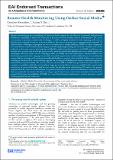Files in this item
Remote health monitoring using online social media
Item metadata
| dc.contributor.author | Khorakhun, C. | |
| dc.contributor.author | Bhatti, S. N. | |
| dc.date.accessioned | 2015-03-24T12:31:03Z | |
| dc.date.available | 2015-03-24T12:31:03Z | |
| dc.date.issued | 2014-11-17 | |
| dc.identifier | 162433377 | |
| dc.identifier | 3db91791-0fbc-468d-8128-3d0e0500a7bb | |
| dc.identifier.citation | Khorakhun , C & Bhatti , S N 2014 , ' Remote health monitoring using online social media ' , EAI Endorsed Transactions on Ubiquitous Environments , vol. 14 , no. 3 , e2 . https://doi.org/10.4108/ue.1.3.e2 | en |
| dc.identifier.other | Bibtex: urn:93e192ea5cd761bc4bc22c6155238d6a | |
| dc.identifier.other | ORCID: /0000-0002-5566-9997/work/29827848 | |
| dc.identifier.uri | https://hdl.handle.net/10023/6298 | |
| dc.description | Chonlatee Khorakhun was funded by the Scottish Informatics and Computer Science Alliance (SICSA). | en |
| dc.description.abstract | Remote monitoring is an essential part of future mHealth systems for the delivery of personal and pervasive healthcare, especially to allow the collection of personal bio-data outside clinical environments. Yet, by its very nature, it presents considerable challenges: it will be a highly distributed task, requiring collection of bio-data for a myriad of cources, to be marshalled at the clinical site via secure communication channels. To address these challenges, we propose the use of an online social media platform (OSMP) as a key component of a near-future remote health monitoring system. By exploiting existing infrastructure, initial costs can be reduced, at the same time as allowing fast and flexible application development. An OSMP would have user benefits also: patients and healthcare professionals can be presented with familiar interfaces, while application developers can work with a set of technologies that are widely used and well-known. Internet-based access also helps to provide wide-ranging connectivity for mobile applications. Additionally, the use of a social media context allows existing social interactions within the healthcare regime to be modelled within a em carer network, working in harmony with, and providing support for, existing relationships and interactions between patients and healthcare professionals. We focus on the use of an OSMP to enable two primitive functions which we consider essential for mHealth, and on which larger personal healthcare services could be built: em remote health monitoring of personal bio-data, and an em alert system for asynchronous notifications. We analyse the general requirements in a carer network for these two primitive functions, in terms of four different viewpoints within the carer network: the em patient, the em doctor in charge, a professional em carer, and a em family member (or friend) of the patient. We discuss the suitability of OSMPs in terms of functionality, performance, security privacy, as well as the potential for cost reduction. | |
| dc.format.extent | 20 | |
| dc.format.extent | 3427822 | |
| dc.language.iso | eng | |
| dc.relation.ispartof | EAI Endorsed Transactions on Ubiquitous Environments | en |
| dc.subject | mHealth | en |
| dc.subject | eHealth | en |
| dc.subject | Remote health monitoring | en |
| dc.subject | Online social media platform | en |
| dc.subject | QA75 Electronic computers. Computer science | en |
| dc.subject.lcc | QA75 | en |
| dc.title | Remote health monitoring using online social media | en |
| dc.type | Journal article | en |
| dc.contributor.sponsor | EPSRC | en |
| dc.contributor.institution | University of St Andrews. School of Computer Science | en |
| dc.identifier.doi | 10.4108/ue.1.3.e2 | |
| dc.description.status | Peer reviewed | en |
| dc.identifier.grantnumber | EP/J016756/1 | en |
This item appears in the following Collection(s)
Items in the St Andrews Research Repository are protected by copyright, with all rights reserved, unless otherwise indicated.

